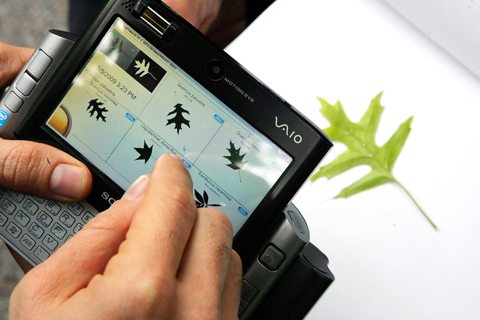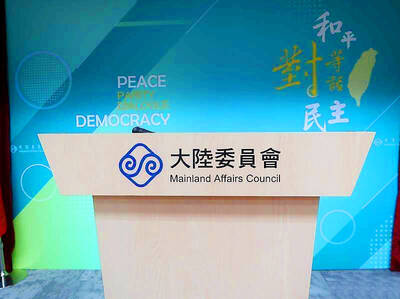The traditional way to identify an unfamiliar tree is to pull out a field guide and search its pages for a matching description. One day people may pull out a smartphone instead, photograph a leaf from the mystery tree and then have the phone search for matching images in a database.
A team of researchers financed by the National Science Foundation has created just such a device — a hand-held electronic field guide that identifies tree species based on the shape of their leaves, said Peter Belhumeur, a professor of computer science at Columbia and a member of the team.
The field guide, now in prototype for iPhones and other portable devices, has been tested at three sites in the northeastern US, including Plummers Island in Maryland and Central Park in New York, said John Kress, a research botanist and curator at the Smithsonian Institution in Washington, who is also on the research team. The computer program compares the leaf snapshot to a library of leaf images.

PHOTO: NY TIMES NEWS SERVICE
“We believe there is enough information in a single leaf to identify a species,” he said. “Our brains can’t remember all of these characteristics, but the computer can.”
The tree guide, and other electronic guides to nature being developed, may be used one day not only by backyard botanists, hikers and children on field trips, but also by scientists and volunteers to compile data for environmental inventories, or as part of species discovery.
Computer applications that automatically identify, for example, a particular bird call or tree species or even an individual dolphin may prove popular with the public, said Bryan Heidorn, a program manager at the National Science Foundation who tried a prototype of the tree program at the Smithsonian. (Heidorn is not connected with the financing of the project.)
The computer tree guide is good at narrowing down and finding the right species near the top of the list of possibilities, he said.
“Instead of flipping through a field guide with 1,000 images, you are given five or 10 choices,” he said.
The right choice may be second instead of first sometimes, “but that doesn’t really matter,” he said. “You can always use the English language — a description of the bark, for instance — to do the final identification.”
The tree guide will be specific to trees and shrubs of the northeastern US, Kress said.
“To apply this system to a forest in Costa Rica, you would have a different library of images,” he said, because there is a different set of species.
Sean White, who created the tree-identifying prototypes for mobile devices as part of his graduate work in computer science at Columbia, hopes to develop mobile applications for the Google, Nokia and Microsoft platforms as well.
The public cannot yet download the software for automatic tree ID, Belhumeur said, although that is planned for the future. The program will probably show up first in educational kiosks at, for example, the Smithsonian, where people will be able to bring in a leaf to have it identified automatically, Kress said.
The computer matching is done using images of recently acquired leaves, Belhumeur said, typically 20 leaves from each species, but sometimes more, that are in the image library. For Plummers Island, the team collected 5,013 leaves representing 157 species; for the trees of Central Park, it collected 4,320 leaves representing 144 species, said White of Columbia. The matching algorithms were developed by David Jacobs, an associate professor of computer science at the University of Maryland, College Park.
Among other automatic identification programs for flora and fauna is one developed by a team of researchers at Eckerd College in St Petersburg, Florida, which includes Kelly Debure, an associate professor of computer science. The program identifies individual dolphins based on photographs of their dorsal fins, which have characteristic nicks and notches.
At one time, the matching was done by hand, “but the task becomes daunting when the catalog grows enormous,” Debure said.
The group primarily studies dolphins in Tampa Bay. The Florida Aquarium there may use the program at a kiosk, she said, so that people can identify individual dolphins in photographs, perhaps leading to a greater concern with water quality and boating regulations affecting dolphins. The software is free to download at code.google.com/p/darwin-ec and is being used by groups around the world, Debure said.
Matthew Brown, supervisor of the soil, water and ecology lab at the Central Park Conservancy, thinks the programs can be useful.
“If people are walking through the park and they come upon a tree that’s not in their field guide they can snap a photo, send it in, and get the name back and find out more information,” he said.
But he believes in traditional education, too.
“People don’t have to take botany for four years, but we shouldn’t lose sight of the value of learning information. If a computer can figure it all out, we can get lazy,” he said.

MORE VISITORS: The Tourism Administration said that it is seeing positive prospects in its efforts to expand the tourism market in North America and Europe Taiwan has been ranked as the cheapest place in the world to travel to this year, based on a list recommended by NerdWallet. The San Francisco-based personal finance company said that Taiwan topped the list of 16 nations it chose for budget travelers because US tourists do not need visas and travelers can easily have a good meal for less than US$10. A bus ride in Taipei costs just under US$0.50, while subway rides start at US$0.60, the firm said, adding that public transportation in Taiwan is easy to navigate. The firm also called Taiwan a “food lover’s paradise,” citing inexpensive breakfast stalls

TRADE: A mandatory declaration of origin for manufactured goods bound for the US is to take effect on May 7 to block China from exploiting Taiwan’s trade channels All products manufactured in Taiwan and exported to the US must include a signed declaration of origin starting on May 7, the Bureau of Foreign Trade announced yesterday. US President Donald Trump on April 2 imposed a 32 percent tariff on imports from Taiwan, but one week later announced a 90-day pause on its implementation. However, a universal 10 percent tariff was immediately applied to most imports from around the world. On April 12, the Trump administration further exempted computers, smartphones and semiconductors from the new tariffs. In response, President William Lai’s (賴清德) administration has introduced a series of countermeasures to support affected

CROSS-STRAIT: The vast majority of Taiwanese support maintaining the ‘status quo,’ while concern is rising about Beijing’s influence operations More than eight out of 10 Taiwanese reject Beijing’s “one country, two systems” framework for cross-strait relations, according to a survey released by the Mainland Affairs Council (MAC) on Thursday. The MAC’s latest quarterly survey found that 84.4 percent of respondents opposed Beijing’s “one country, two systems” formula for handling cross-strait relations — a figure consistent with past polling. Over the past three years, opposition to the framework has remained high, ranging from a low of 83.6 percent in April 2023 to a peak of 89.6 percent in April last year. In the most recent poll, 82.5 percent also rejected China’s

PLUGGING HOLES: The amendments would bring the legislation in line with systems found in other countries such as Japan and the US, Legislator Chen Kuan-ting said Democratic Progressive Party (DPP) Legislator Chen Kuan-ting (陳冠廷) has proposed amending national security legislation amid a spate of espionage cases. Potential gaps in security vetting procedures for personnel with access to sensitive information prompted him to propose the amendments, which would introduce changes to Article 14 of the Classified National Security Information Protection Act (國家機密保護法), Chen said yesterday. The proposal, which aims to enhance interagency vetting procedures and reduce the risk of classified information leaks, would establish a comprehensive security clearance system in Taiwan, he said. The amendment would require character and loyalty checks for civil servants and intelligence personnel prior to